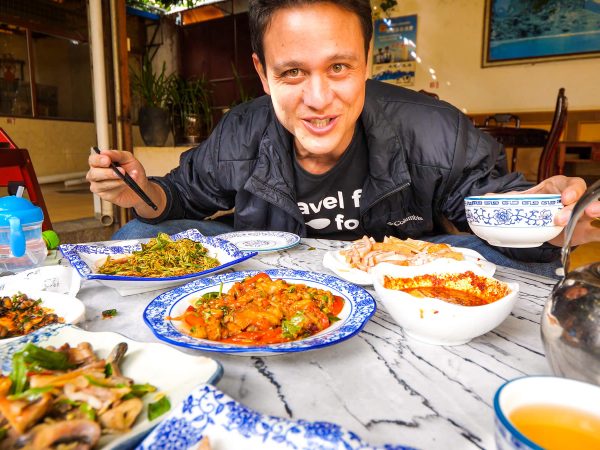

I specifically remember when I was growing up, my mom used to always tell me,
“beef is alright to eat rare, but ALWAYS make sure pork is fully cooked.”
(this came from my mom who is Chinese)
Alright, now let’s proceed…

Many dishes in Thailand are consumed raw, everything from a huge assortments of salads, to ceviche style shrimp cooked in the acid of lime juice, to sok lek, a popular Isaan dish of raw beef.
But there’s another Thai dish, eaten specifically in the north of Thailand, that likely goes against ALL cooking advice you were ever taught…
…the main ingredient: fresh pig’s blood, and not just pig’s blood, RAW pig’s blood.
It’s known in Thai as หลู้ which I’m going to spell as “lou,” it rhymes with “you.”
Warning: I’m not writing this article to really say raw pig’s blood is a Thai dish you should try, because it’s definitely not the safest dish. But I’m writing this article, mostly to explain about it, and to share about it, because it’s a real Thai dish.
Eat raw pig’s blood soup at your own risk!

Market in Chiang Rai
When I was in Chiang Rai, filming for the Thai food TV show, one day we met up with P’Chan, the owner of a famous northern Thai restaurant in Chiang Rai called Lu Lam (and on a side note, Lu Lam (หลู้ลำ) is a wonderful restaurant to eat at in Chiang Rai when you’re there, and they have a full menu of different dishes, not just lou หลู้).
P’Chan and I first went to the market, and went to his preferred butcher, that he knows personally and frequents.
When you’re dealing with the subject of eating raw pig’s blood, I think it’s good to know your source.
Not only did we buy a big bag of pig’s blood, we also bought some of the pork neck fat, and a nice little kidney (which at the time of purchasing, I had no idea what it was going to be used for!?).

Wasp larvae
Along with buying fresh pig’s blood, we also searched for what’s called dua daw (ตัวต่อ) in Thai, wasp larvae, a critter I hadn’t eaten before.
Get exclusive updates
Enter your email and I’ll send you the best travel food content.
Wasp larvae is a common food in northern Thailand, and it’s only available for a few months of the year, during the main rainy season which lasts from about July – September.
In these months you’ll find lots of wasp larvae in the markets, but not during season it’s almost impossible to find.

We’ll come back to the wasp larvae later.

Back to Lu Lam restaurant
After we finished shopping, and purchased all the ingredients we needed, P’Chan and I headed back to Lu Lam (his restaurant) to get started preparing two interesting and exotic northern Thai dishes (or shall I just say, mixing (since no heat was needed!).

Lou recipe (หลู้)
I was immediately impressed by just how many spices and ingredients went into the recipe for lou (หลู้) – so many different delicious spices were about to be mixed up.

Makhwaen (มะแข่วน)
One spice that’s quite interesting and commonly used only in northern Thai cuisine, is something called makhwaen (มะแข่วน).
It’s a spice that’s related to Sichuan pepper, and has a bit of heat and a bit of a numbing effect to it. Anyway I love it, and it was about to go into our blood.

P’Chan is not only the owner of Lu Lam and an expert chef, he was an incredibly nice man, and it was a real honor to meet him.
He knew exactly what he was doing when it came to the lou (หลู้) recipe, handling all the steps with ease, and following correct blood handling procedures.
He explained to me that lou (หลู้) is often a men’s dish, one of the northern dishes that men often eat along with shots of Thai liquor – and this is definitely a dish that really needs to be paired with whiskey, to kill the bacteria.

Cleaning the blood
Making lou (หลู้), the first step is to clean the blood.
We bought both lemongrass and Thai holy basil, but P’Chan said that those two famous Thai herbs weren’t actually included in the dish, but were just used to clean the blood.
So the first step was to take slices of lemongrass and holy basil, and P’Chan wrung the blood through the herbs, explaining that they would remove any bad smells and cleanse the blood.

Raw egg and spices
After cleansing the blood, it was then time crack in a couple of raw eggs, and then add in all the spices, as well as a shot of condensed milk.
Then came the spices. Chili flakes, makhwaen (which I explained a bit above), cumin (which isn’t commonly used in Thai food), salt, pickled and fried garlic, some kind of a burnt chili sauce, and some condensed milk, all went in.
After mixing all the blood soup together very delicately, P’Chan then topped it with a handful of something like rice cracker noodles, fried kaffir lime leaves, fried chilies, bits of crunchy fried chicken skin, and finally a handful of chopped cilantro and green onions.

Raw blood soup not enough…?
If the raw pig’s blood soup isn’t quite enough for you, you’ll be happy to know that lou (หลู้), in Chiang Rai, is often eaten with slices of raw pig’s kidney and raw pig’s neck fat.
Yum!

I’m usually pretty excited about trying anything and everything that I’ve never tried before, no matter how exotic or bizarre sounding, but raw pig’s kidney didn’t actually sound all that appealing to me at first – I have to admit.
But nevertheless, I wanted to give it a shot and a chance.
P’Chan put a slice of slimy looking kidney on my spoon, and then dipped it into the blood soup, for my first bite.

How does lou (หลู้) taste?
I was shocked when I had my first bite of lou (หลู้).
And I’m talking shocked in a great way… it was honestly delicious.
I could actually not even taste really that it was blood, it really didn’t have a blood or even an irony flavor to it.
The blood had the texture of whole milk (liquid but thick), but it was that spice blend that really made it tasty. The flavor of cumin, the peppery makhwaen (มะแข่วน), the lime zesty of kaffir lime leaf, and the freshness of the cilantro.
It was seriously tasty.
The thin slice of raw kidney could be compared to something like a cloud ear mushroom, tender but kind of rubbery just for the first bite. It was actually quite good.

Wasp larvae chili dip (นำ้พริกตัวต่อ)
Remember the wasp larvae we also purchased at the market?
After finishing the recipe for lou (หลู้), and eating quite a bit of it, it was then time to move onto the next exotic northern Thai food dish we were going to prepare: a chili sauce dip made with wasp larvae, known as nam prik dua daw (นำ้พริกตัวต่อ).
This was a version of nam prik I had never tried before.
The first step was to take green banana peppers, garlic, and shallots, and roast them until slightly blackened, to give the chili sauce a nice smokey flavor.

Next, we pounded the nam prik into a paste, including the chilies, garlic, shallots, fish sauce, and finally a few big handfuls of steamed wasp larvae (ตัวต่อ).
It was basically the same recipe as nam prik noom (a northern Thai chili sauce that kind of reminds me of a Mexican green chili salsa), except with the added wasp larvae ingredient.

How did it taste?
I have to say that the nam prik dua daw (นำ้พริกตัวต่อ) was excellent.
The pepper and garlic gave it a beautiful smokey flavor, it was slightly spicy, and the addition of the wasp larvae gave the chili dip a real richness and creaminess.
I guess the wasp larvae are basically like little nuggets of fatty cream, and they bumped the nam prik to the next level, making it almost buttery and so creamy – I loved it.

I loved it so much, I polished off most of the bowl in a few minutes, along with a garden of fresh herbs and vegetables.

Conclusion
Lou (หลู้) is a traditional northern Thai dish of raw pig’s blood mixed with spices, and often served with raw pig’s kidney on the side.
P’Chan, the owner of Lu Lam, a wonderful northern Thai restaurant in Chiang Rai, showed me his recipe for this northern delicacy. It was interesting to learn about the many ingredients and the culture of eating lou (หลู้) in Thailand.
And how did it taste? I honesty thought it was delicious – the blend of spices was amazing, and it really didn’t even contain a strong taste of blood. It tastes much better than it may sound!
Want to try some lou (หลู้)?
Get exclusive updates
Enter your email and I'll send you the best travel food content.



